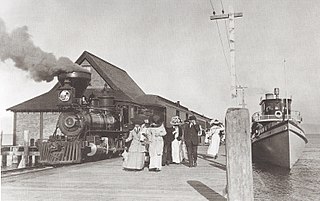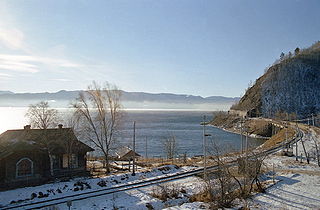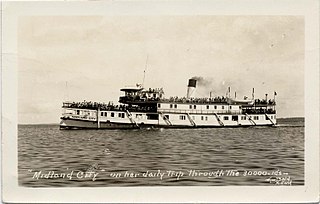
Lake Baikal is a rift lake in Russia. It is situated in southern Siberia, between the federal subjects of Irkutsk Oblast to the northwest and the Republic of Buryatia to the southeast. With 23,615.39 km3 (5,670 cu mi) of water, Lake Baikal is the world's largest freshwater lake by volume, containing 22–23% of the world's fresh surface water, more than all of the North American Great Lakes combined. It is also the world's deepest lake, with a maximum depth of 1,642 metres, and the world's oldest lake, at 25–30 million years. At 31,722 km2 (12,248 sq mi)—slightly larger than Belgium—Lake Baikal is the world's seventh-largest lake by surface area. It is among the world's clearest lakes.

The Trans-Siberian Railway, historically known as the Great Siberian Route and often shortened to Transsib, is a large railway system that connects European Russia to the Russian Far East. Spanning a length of over 9,289 kilometers, it is the longest railway line in the world. It runs from the city of Moscow in the west to the city of Vladivostok in the east.
Baykal, or Lake Baikal, is a lake in southern Siberia, Russia.

Sir W G Armstrong Whitworth & Co Ltd was a major British manufacturing company of the early years of the 20th century. With headquarters in Elswick, Newcastle upon Tyne, Armstrong Whitworth built armaments, ships, locomotives, automobiles and aircraft.

SS American Victory is a Victory ship which saw brief service in the Pacific Theater of Operations during the final months of World War II, the Korean War from 1951–1954, and the Vietnam War from 1966–1969. Built in June 1945, she carried ammunition and other cargo from Los Angeles to Southeast Asia, then ferried cargo, equipment and troops back to the U.S. after the war ended. She survived two typhoons and one hurricane.

USCGC Mackinaw (WAGB-83) is a 290-foot (88 m) former Coast Guard icebreaker on exhibit as a museum ship at the Icebreaker Mackinaw Maritime Museum in Mackinaw City, Michigan. The vessel has been known as the "Queen of the Great Lakes" and "The Largest Icebreaker on the Great Lakes"; the site states that "she was built during World War II to meet the heavy demands of war materials and transportation during the winter months".

Stepan Osipovich Makarov was a Russian vice-admiral, commander in the Imperial Russian Navy, oceanographer, member of the Russian Academy of Sciences, and author of several books. He was a pioneer of insubmersibility theory, and developer of a Cyrillic-based semaphore alphabet. A proponent of icebreaker use, he supervised the first ever polar icebreaker construction. Makarov also designed several ships.

Sadko was a Soviet icebreaker known for its role in scientific expeditions in the Arctic. Built as SS Lintrose in 1913 for ferry service in Newfoundland, she was sold to the government of the Russian Empire in 1915 and renamed Sadko. In Russia, she was used as a freighter in the Arctic before sinking in 1916.

SS Tahoe was a steamship that operated on Lake Tahoe at the end of the 19th century and the first half of the 20th. Scuttled in 1940, the wreck presently lies in 400 feet (120 m) of water off Glenbrook, Nevada. The wreck was first visited in 2002 by a team from New Millennium Dive Expeditions (NMDE) in a record-setting high-altitude dive for Lake Tahoe. As a result of the work that NMDE did on the Tahoe site from 1999 up to their dives in 2002, Tahoe became the first maritime site in Nevada to be listed in the National Register of Historic Places.

Chief Wawatam was a coal-fired steel ship that was based, for most of its 1911–1984 working life, in St. Ignace, Michigan. The vessel was named after a distinguished Ojibwa chief of the 1760s. In initial revenue service, the Chief Wawatam served as a train ferry, passenger ferry and icebreaker that operated year-round at the Straits of Mackinac between St. Ignace and Mackinaw City, Michigan. During the winter months, it sometimes took many hours to cross the five-mile-wide Straits, and Chief Wawatam was fitted with complete passenger hospitality spaces.

The Circum–Baikal railway is a historical railway in the Irkutsk region of Russia. It runs along the Northern shore of the Southern extremity of Lake Baikal from the town of Slyudyanka to the Baikal settlement. Until the middle of the 20th century the Circum–Baikal railway was part of the main line of Trans–Siberian Railway; later on, however, a duplicate section of the railway was built. Sometimes called a unique achievement in engineering, the Circum–Baikal is one of the picturesque sights of the area around Lake Baikal.
The Mackinac Transportation Company was a train ferry service that shuttled railroad cars across the Straits of Mackinac from 1881 until 1984. It was best known as the owner and operator, from 1911 until 1984, of the SS Chief Wawatam, an icebreaking train ferry.
The Eastern-Siberian Inland Navigation Company (ESINC) is a company, which carries out goods and passengers by inland waterways of Irkutsk Oblast and the Buryatia Republic.

Sampo was a Finnish state-owned steam-powered icebreaker. Built in 1898 by Sir W.G. Armstrong, Whitworth & Co Ltd in Newcastle upon Tyne, United Kingdom and named after a magical artifact from the Finnish mythology, she was the second state-owned icebreaker of Finland and the first European icebreaker equipped with a bow propeller. When Sampo was decommissioned and broken up in 1960, she was also the second last steam-powered icebreaker in the Finnish icebreaker fleet.

SS Midland City was originally a Canadian side-wheel steamboat that provided passenger and cargo transportation on the Great Lakes from 1871 until 1955. Originally named Maud, then America, she underwent several extensive refits over her 84-year service, and saw several owners. The ship was intentionally run aground and burnt to the waterline in 1955 near the mouth of the Wye River in Midland Bay. The wreck is intact and visible above the water to this day, where it acts as a breakwater for the Wye Heritage Marina and local attraction.
The Battle of Lake Baikal was a naval battle undertaken by Czechoslovak forces.

Baikalia is a vague geographical term referring to the region around Lake Baikal. It is less common than the concept of Transbaikalia, the area to the east of Lake Baikal. The term Baikalia is loosely defined and has no official definition.

The SS Pere Marquette was the world's first steel train ferry. It sailed on Lake Michigan and provided a service between the ports of Ludington, Michigan, and Manitowoc, Wisconsin, for the Pere Marquette Railway from 1897 to 1930. The railway used the name Pere Marquette for many of its ships and ferries, adding a number to the end of the name.
















